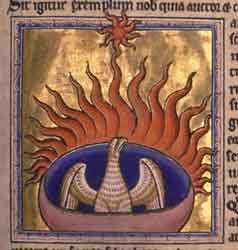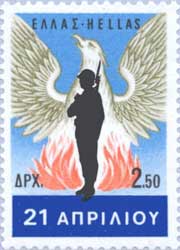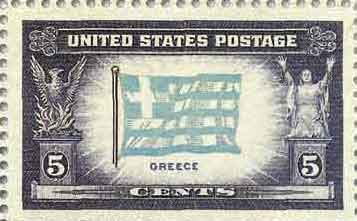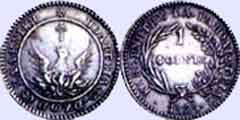.

The phoenix from the Aberdeen Bestiary.
In ancient Egyptian mythology and in myths derived from it, the phoenix is a mythical sacred firebird.
Said to live for 500 or for 1461 years, the phoenix is a male bird with beautiful gold and red plumage. At the end of its life-cycle the phoenix builds itself a nest of cinnamon twigs that it then ignites; both nest and bird burn fiercely and are reduced to ashes, from which a new, young phoenix arises. The new phoenix embalms the ashes of the old phoenix in an egg made of myrrh and deposits it in Heliopolis ("the city of the sun" in Greek), located in Egypt.
Although descriptions (and life-span) vary, the phoenix became popular in early Christian art and literature as a symbol of the resurrection, of immortality, and of life-after-death. The early Christians were convinced the phoenix was a real living creature.
It was also famed for being a symbol of the rise and fall of society in Ray Bradbury's Fahrenheit 451. The pattern of an over complacent and abusive society's destruction yeilding a fresh new start was compared to the Phoenix's mythological pattern of consumption by flame, then ressurection out of ashes.
Originally, the phoenix was identified by the Egyptians as a stork or heron-like bird called a benu, known from the Book of the Dead and other Egyptian texts as one of the sacred symbols of worship at Heliopolis, closely associated with the rising sun and the Egyptian sun-god Ra.
As Britannica 1911 continues:
... whence it is represented as "self-generating" and called "the soul of Ra (the sun)," "the heart of the renewed Sun". All the mystic symbolism of the morning sun, especially in connexion with the doctrine of the future life, could thus be transferred to the benu, and the language of the hymns in which the Egyptians praised the luminary of the dawn as he drew near from Arabia, delighting the gods with his fragrance and rising from the sinking flames of the morning glow, was enough to suggest most of the traits materialized in the classical pictures of the phoenix.
The Greeks adapted the word benu (and also took over its further Egyptian meaning of date palm tree), and identified it with their own word phoinix, meaning the colour purple-red or crimson (cf Phoenicia). They and the Romans subsequently pictured the bird more like a peacock or an eagle. According to the Greeks the phoenix lived in Arabia next to a well. At dawn, it bathed in the water of the well, and the Greek sun-god Apollo stopped his chariot (the sun) in order to listen.

Greek Stamp of the symbol of the Greek Military Regime (1967 / 74). The Phoenix and the silhouette of the soldier bearing a bayonet rifle was the emblem of the Junta. On the header the word Greece and on the footer the words 21 April can be seen in Greek. The burning Phoenix ironically can be considered as a symbol of Democracy.

United States Stamp, Greece with the Phoenix
This myth is famously referred to in Shakespeare's play The Tempest,
that in Arabia
There is one tree, the phoenix' throne; one phoenix
At this hour reigning there.
-(III.III.28)
One inspiration that has been suggested for the Egyptian phoenix is a specific bird species of East Africa. This bird nests on salt flats that are too hot for its eggs or chicks to survive; it builds a mound several inches tall and large enough to support its egg, which it lays in that marginally cooler location. The hot air rising around these mounds resembles the turbulence of a flame.
In Russian folklore, the phoenix appears as the Firebird (Жар-Птица), or firebird, subject of the famous 1910 ballet score by Stravinsky. The phoenix featured in the flags of Alexander Ypsilantis and of many other captains during the Greek Revolution, symbolizing Greece's rebirth, and was chosen by John Capodistria as the first Coat of Arms of the Greek State (1828-1832). In addition, the first modern Greek currency bore the name of phoenix. Despite being replaced by a royal Coat of Arms, it remained a popular symbol, and was used again in the 1930s by the Second Hellenic Republic. However, its use by the military junta of 1967-1974 made it extremely unpopular, and it has almost disappeared from use after 1974, with the notable exception of the Order of the Phoenix.
The phoenix appears also on the city flags and seals of both Atlanta (torched in the US Civil War) and San Francisco (destroyed by earthquake and fire in 1906) to symbolize their respective rebirths from the ashes.
See also
other mythological figures called Phoenix
Links
- Entry for the Phoenix in The Aberdeen Bestiary
- The phoenix as described by Tacitus
- Phoenix Redidivus , commercial website restricted access
See also : Greek Mythology. Paintings, Drawings
| Ancient Greece
Science, Technology , Medicine , Warfare, , Biographies , Life , Cities/Places/Maps , Arts , Literature , Philosophy ,Olympics, Mythology , History , Images Medieval Greece / Byzantine Empire Science, Technology, Arts, , Warfare , Literature, Biographies, Icons, History Modern Greece Cities, Islands, Regions, Fauna/Flora ,Biographies , History , Warfare, Science/Technology, Literature, Music , Arts , Film/Actors , Sport , Fashion --- |
Retrieved from "http://en.wikipedia.org"
All text is available under the terms of the GNU Free Documentation License



